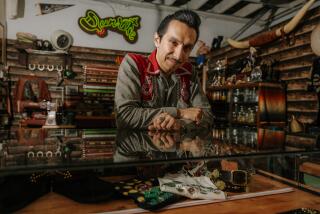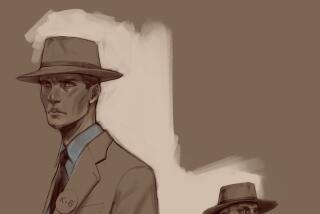In Big Sky Country, 1 Size Doesn’t Fit All
- Share via
BILLINGS, Mont. — It turns out there are more potato heads among us than we might have guessed.
For instance, me.
This discovery occurred because, like scores of people each year, I made an excuse to travel to eastern Montana and to insert my head into a “conformeur”--a spindly, 150-year-old machine with levers and springs that looks something like a circular harpsichord the size of a half-melon.
The levers and springs are connected to pins. When the conformeur comes to rest on your head, 1 1/2 inches above your eyes, the machine’s operator presses a 3-by-5 piece of paper onto the pins. Perforations provide a miniature template of one’s skull in cross-section.
Forget the symmetrical ovals from those how-to-draw art books. My own head appeared before me as a misshapen ellipse that had been dropped and not so gently kicked. Or, yes, like a potato sliced in half lengthwise.
No wonder I cannot find a good hat that fits.
Which is precisely why one ventures to the industrial side of Billings, to a gaily painted two-story building with country music playing in the background and clouds of steam rising inside. Here, with money and patience, you can get a hat that rides on your head the way your bottom might rest on the driver’s saddle of a Rolls-Royce.
Ritch Rand is one of the great custom cowboy hat makers of the American West--and probably the best known. Here at Rand’s Custom Hats, he and six hatters work against a 12-week backlog to supply cowboys, cowgirls, Hollywood actors, guides, adventurers, fly fishermen, park rangers and city strollers with fur felt hats of extraordinary quality: Hats molded to the curves, dents and lumps of our heads; hats shaped with steam and century-old hot-irons. Hats of beaver felt that are scraped with whalebone, sanded velvet smooth and embossed with 8X and 10X and 40X marks of quality.
“Most people aren’t normal,” says the 50-year-old Rand, by way of explaining the fit of a hat.
A cynic might observe the same about the Western hat itself and those who wear one.
The cowboy hat started as a joke, after all. According to the story as recounted by Rand in the 1995 volume he co-authored, “The Cowboy Hat Book,” Philadelphia hatter John B. Stetson came West on a hunting trip. He showed his companions he could make cloth out of fur without weaving--that is, by felting. Then, for a laugh, he shaped the felt into a hat with a colossal brim. Right away, a person could tell that such a hat would put up a fight against sun and rain, and Stetson sold it to a horseman. That was in 1865.
American cowhands, like nomadic peoples all over the world, traditionally invested their wealth in things they could use and carry with them--boots and saddles, ropes and buckles--and, more recently, pickups. A good Stetson became the essential finishing touch to every wrangler’s get-up.
Today, of course, the cowboy hat is known throughout the world as distinctly American, except in America, where it is provincially Western.
For the last 25 years, Rand has been making a living from the knowledge that, entirely apart from periodic fashion fads, cowpunchers are willing to spend a week’s pay or more for a good hat. That might be $300, which is the average price today for a Rand hat in 75 or so catalog styles, or whatever other shape a customer chooses.
There are mountainous Tom Mix packer hats, Western derbies, “Raiders of the Lost Ark” safari hats, Belle Starr models with an attached earring, full-brimmed gamblers or, my own choice, a pre-Stetson era “San Fran” fedora.
For $40 more, a hat can be “distressed” so it looks like six months of sweat and dusty trail--a feature more popular in urban California than among Montana buyers.
As Rand likes to explain, a factory can produce a hat by machine in 10 minutes. It takes him almost that long to stamp the customer’s name in gold on the sweatband. In fact, it can take a single hatter a full day to make the best of Rand’s hats.
Although he produces hats in standard sizes for sale in Western stores and via mail order, Rand’s reputation is built on bespoke work. And for that, the secret is the miniature paper template.
It is trimmed with scissors and inserted into the conformeur’s elegant pot-shaped companion, the “formateur”--19th century machines made in France and still unbeatable for fitting hats. Small wooden legs are adjusted around the miniature template to produce a mold in the exact size and potato shape of the customer’s head at the hat line.
Around that, the crown of the hat is steamed to size from a floppy cone of factory-made felt. Grades of felt are tricky business. Many hatters use their own version of the “X” scale. An 8X Rand signifies 80% beaver and 20% rabbit fur. A 10X is pure beaver. A 40X is prime belly fur.
The brim is ironed flat. The felt is sanded. Using curved irons, heated on a hot plate, the brim is rolled. Perhaps a ribbon is sewn over the edge. Creases in the crown are sculpted by hand and steam. A liner is glued in and a sweatband and exterior band are hand stitched. The hat is given a once-over with a barber’s horsehair brush. Then that moment when the finished work glides onto your head and locks into place.
There is an old cowboy put-down about someone being all hat and no cattle. But having the proper hat, at least, is a start.
More to Read
Sign up for The Wild
We’ll help you find the best places to hike, bike and run, as well as the perfect silent spots for meditation and yoga.
You may occasionally receive promotional content from the Los Angeles Times.






